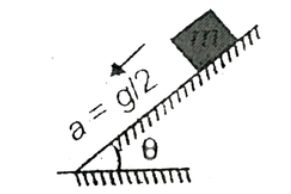A small mass slides down an inclined plane of inclination θ with the horizontal the coefficient of friction is μ=μ0x, where x is the distance through which the mass slides down. Then the distance covered by the mass before it stops is
1μ0tanθ
4μ0tanθ
21μ0tanθ
1μ0tanθ
The correct Answer is:A
To solve the problem of a small mass sliding down an inclined plane with a variable coefficient of friction, we can follow these steps:
Step 1: Identify the forces acting on the mass
The mass m experiences the following forces:
- Gravitational force mg acting downwards.
- Normal force N acting perpendicular to the inclined plane.
- Frictional force Ff acting up the incline, which is given by Ff=μN.
Step 2: Resolve the gravitational force
The gravitational force can be resolved into two components:
- Parallel to the incline: mgsinθ
- Perpendicular to the incline: mgcosθ
Step 3: Write the expression for the normal force
The normal force N is equal to the perpendicular component of the gravitational force:
N=mgcosθ
Step 4: Write the expression for the frictional force
Given that the coefficient of friction μ=μ0x, the frictional force becomes:
Ff=μN=μ0x(mgcosθ)
Step 5: Set up the equation of motion
Using Newton's second law, we can write the equation of motion along the incline:
mgsinθ−Ff=ma
Substituting for Ff:
mgsinθ−μ0x(mgcosθ)=ma
Dividing through by m:
gsinθ−μ0xgcosθ=a
Step 6: Express acceleration in terms of velocity and position
Using the relation a=vdvdx, we can rewrite the equation:
vdvdx=gsinθ−μ0xgcosθ
Step 7: Separate variables and integrate
Rearranging gives:
∫vdv=∫(gsinθ−μ0xgcosθ)dx
Integrating both sides:
v22=gsinθ⋅x−μ0gcosθ2x2+C
Since the mass starts from rest, when x=0, v=0, thus C=0.
Step 8: Set the final condition when the mass stops
When the mass comes to a stop, v=0:
0=gsinθ⋅xm−μ0gcosθ2x2m
Factoring out xm:
xm(gsinθ−μ0gcosθ2xm)=0
Since xm≠0, we can set the term in parentheses to zero:
gsinθ=μ0gcosθ2xm
Step 9: Solve for xm
Rearranging gives:
xm=2gsinθμ0gcosθ
Simplifying:
xm=2sinθμ0cosθ=2μ0tanθ
Final Result
Thus, the distance covered by the mass before it stops is:
xm=2μ0tanθ
---
The mass m experiences the following forces:
- Gravitational force mg acting downwards.
- Normal force N acting perpendicular to the inclined plane.
- Frictional force Ff acting up the incline, which is given by Ff=μN.
The gravitational force can be resolved into two components:
- Parallel to the incline: mgsinθ
- Perpendicular to the incline: mgcosθ
The normal force N is equal to the perpendicular component of the gravitational force:
N=mgcosθ
Given that the coefficient of friction μ=μ0x, the frictional force becomes:
Ff=μN=μ0x(mgcosθ)
Using Newton's second law, we can write the equation of motion along the incline:
mgsinθ−Ff=ma
Substituting for Ff:
mgsinθ−μ0x(mgcosθ)=ma
Dividing through by m:
gsinθ−μ0xgcosθ=a
Using the relation a=vdvdx, we can rewrite the equation:
vdvdx=gsinθ−μ0xgcosθ
Rearranging gives:
∫vdv=∫(gsinθ−μ0xgcosθ)dx
Integrating both sides:
v22=gsinθ⋅x−μ0gcosθ2x2+C
Since the mass starts from rest, when x=0, v=0, thus C=0.
When the mass comes to a stop, v=0:
0=gsinθ⋅xm−μ0gcosθ2x2m
Factoring out xm:
xm(gsinθ−μ0gcosθ2xm)=0
Since xm≠0, we can set the term in parentheses to zero:
gsinθ=μ0gcosθ2xm
Rearranging gives:
xm=2gsinθμ0gcosθ
Simplifying:
xm=2sinθμ0cosθ=2μ0tanθ
Thus, the distance covered by the mass before it stops is:
xm=2μ0tanθ
Topper's Solved these Questions
- WORK, ENERGY & POWERBOOK - DC PANDEY ENGLISHCHAPTER - WORK, ENERGY & POWEREXERCISE - Level 2 More Than One Correct
9 Videos
- WORK, ENERGY & POWERBOOK - DC PANDEY ENGLISHCHAPTER - WORK, ENERGY & POWEREXERCISE - Level 2 Subjective
15 Videos
- WORK, ENERGY & POWERBOOK - DC PANDEY ENGLISHCHAPTER - WORK, ENERGY & POWEREXERCISE - Level 1 subjective
27 Videos
- WAVE MOTIONBOOK - DC PANDEY ENGLISHCHAPTER - WAVE MOTIONEXERCISE - Integer Type Question
11 Videos
- WORK, ENERGY AND POWERBOOK - DC PANDEY ENGLISHCHAPTER - WORK, ENERGY AND POWEREXERCISE - MEDICAL ENTRACES GALLERY
33 Videos
Similar Questions
A small mass slides down an inclined plane of inclination θ with the horizontal. The co-efficient of friction is μ=μ0 x where x is the distance through which the mass slides down and μ0 a constant. Then, the distance covered by the mass before it stops is
View SolutionA block slides down an inclined plane that makes an angle θ with the horizontal. If the coefficient of kinetic friction is μ, find the acceleration of the block.
View SolutionA block slides down on inclined plane (angle of inclination 60∘ ) with an accelration g/2 Find the coefficient friction

View SolutionWhen a body of mass M slides down an inclined plane of inclination θ, having coefficient of friction μ through a distance s, the work done against friction is :
View SolutionA block of mass m moves with constant speed down the inclined plane of inclination θ. Find the coefficient of kinetic friction.

View SolutionA block of mass m slides down an inclined plane which makes an angle θ with the horizontal. The coefficient of friction between the block and the plane is μ. The force exerted by the block on the plane is
View SolutionA block of mass m slides down an inclined plane of inclination θ with uniform speed. The coefficient of friction between the block and the plane is μ. The contact force between the block and the plane is
View SolutionA small block starts sliding down an inclined plane subtending an angle θ with the horizontal . The coefficient of friction between the block and plane depends on the distance covered from rest along the plane as μ=μ0x where μ0 is a constant . Find (a) the distance covered by the block down the plane till it stops sliding and (b) its maximum velocity during this journey .
View SolutionA body which was released from rest, slides down on an inclined plane of inclination θ. The coefficient of friction dowh the plane varies as μ=kx where k is a spositive constant and x is the distance moved by the body down the plane. The speed of the body 'v' versus distance 'x' graph will be as :
View SolutionA block of mass m slides down a rough inclined plane with an acceleration g2

View Solution
